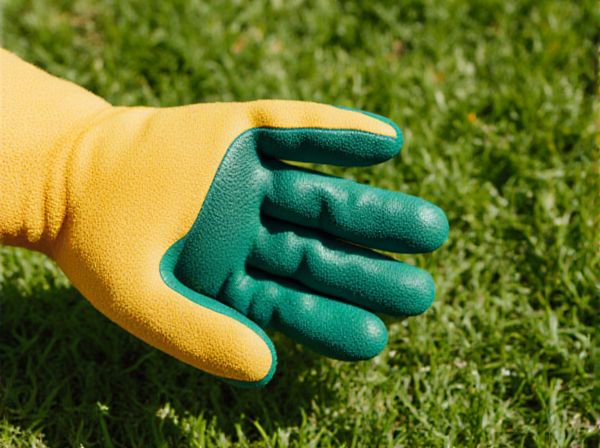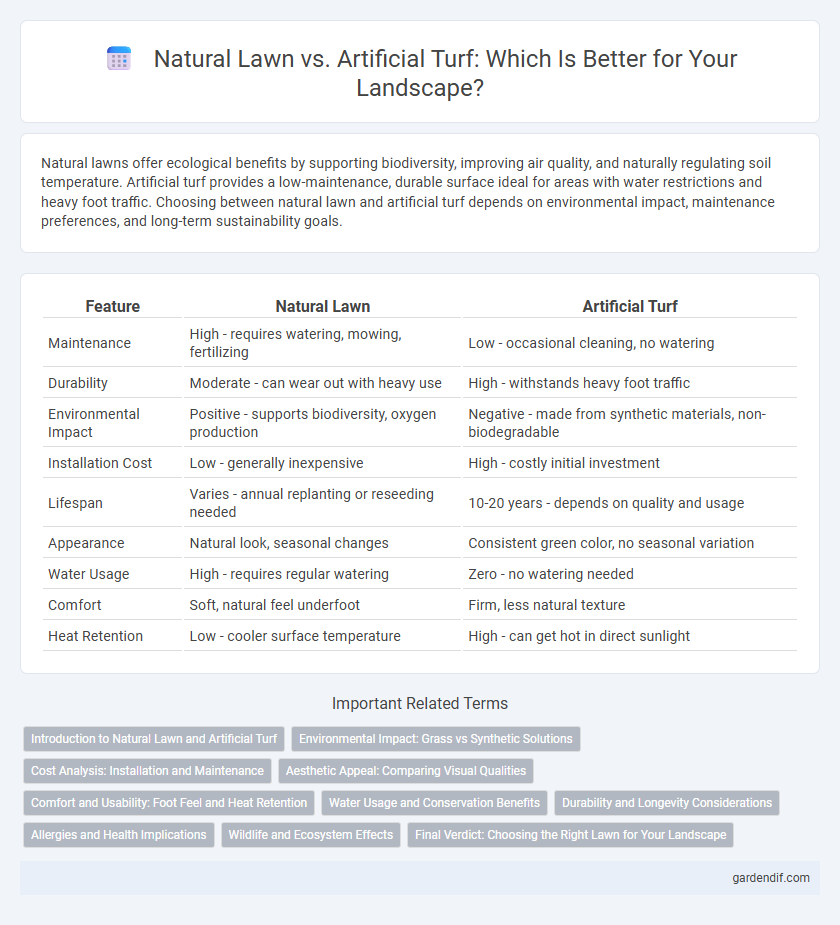
Natural Lawn vs Artificial Turf Illustration
Natural lawns offer ecological benefits by supporting biodiversity, improving air quality, and naturally regulating soil temperature. Artificial turf provides a low-maintenance, durable surface ideal for areas with water restrictions and heavy foot traffic. Choosing between natural lawn and artificial turf depends on environmental impact, maintenance preferences, and long-term sustainability goals.
Table of Comparison
| Feature | Natural Lawn | Artificial Turf |
|---|---|---|
| Maintenance | High - requires watering, mowing, fertilizing | Low - occasional cleaning, no watering |
| Durability | Moderate - can wear out with heavy use | High - withstands heavy foot traffic |
| Environmental Impact | Positive - supports biodiversity, oxygen production | Negative - made from synthetic materials, non-biodegradable |
| Installation Cost | Low - generally inexpensive | High - costly initial investment |
| Lifespan | Varies - annual replanting or reseeding needed | 10-20 years - depends on quality and usage |
| Appearance | Natural look, seasonal changes | Consistent green color, no seasonal variation |
| Water Usage | High - requires regular watering | Zero - no watering needed |
| Comfort | Soft, natural feel underfoot | Firm, less natural texture |
| Heat Retention | Low - cooler surface temperature | High - can get hot in direct sunlight |
Introduction to Natural Lawn and Artificial Turf
Natural lawns consist of living grass that provides oxygen, absorbs carbon dioxide, and supports biodiversity while requiring regular maintenance such as watering, mowing, and fertilizing. Artificial turf is a synthetic surface made from plastic fibers designed to mimic natural grass without the need for watering or mowing, offering durability and low maintenance. Both options serve landscaping needs but differ significantly in environmental impact, upkeep, and longevity.
Environmental Impact: Grass vs Synthetic Solutions
Natural lawns provide essential ecological benefits by supporting biodiversity, improving air quality, and naturally filtering water. Artificial turf eliminates the need for watering and chemical fertilizers, reducing water consumption and chemical runoff but contributes to microplastic pollution and heat retention issues. Choosing between grass and synthetic solutions requires balancing environmental impacts such as carbon footprint, resource use, and ecosystem disruption.
Cost Analysis: Installation and Maintenance
Natural lawn installation costs vary from $1 to $2 per square foot, while artificial turf ranges between $5 and $20 per square foot, depending on material quality and site preparation. Maintenance expenses for natural lawns include mowing, watering, fertilizing, and pest control, averaging $500 to $1,200 annually, whereas artificial turf requires minimal upkeep, primarily occasional cleaning and infill replenishment, costing about $100 to $300 per year. Over a 10-year period, artificial turf can offer significant savings despite higher upfront costs due to reduced water consumption and maintenance labor.
Aesthetic Appeal: Comparing Visual Qualities
Natural lawns offer a rich, organic texture and vibrant color variations that create a dynamic and authentic landscape appearance. Artificial turf provides a consistently uniform green color and neatly manicured look, enhancing curb appeal with low maintenance. Both options influence the overall aesthetic appeal, with natural grass showcasing seasonal changes and synthetic turf maintaining a pristine year-round appearance.
Comfort and Usability: Foot Feel and Heat Retention
Natural lawn offers a softer foot feel and cooler surface temperature, enhancing comfort during barefoot activities. Artificial turf tends to retain more heat, often becoming uncomfortably warm in direct sunlight, which can limit usability in hot climates. Choosing between the two depends on balancing comfort preferences with maintenance considerations for specific landscape environments.
Water Usage and Conservation Benefits
Natural lawns require significantly more water, averaging 20,000 gallons annually per 1,000 square feet, while artificial turf eliminates irrigation needs, conserving substantial water resources. Artificial turf reduces water consumption by up to 70%, making it a sustainable choice in drought-prone regions. Opting for synthetic grass enhances water conservation efforts and lowers utility costs linked to outdoor landscaping.
Durability and Longevity Considerations
Natural lawns offer moderate durability but require regular maintenance such as watering, mowing, and pest control to sustain their health and appearance. Artificial turf provides superior durability and longevity, often lasting 15 to 20 years with minimal upkeep while resisting weather damage, heavy foot traffic, and fading. The choice between natural and artificial surfaces depends on the expected usage intensity, climate conditions, and willingness to invest in ongoing care or initial installation costs.
Allergies and Health Implications
Natural lawns can trigger allergies due to pollen, mold, and grass blades, potentially exacerbating asthma and hay fever symptoms in sensitive individuals. Artificial turf greatly reduces exposure to common allergens, offering a hypoallergenic alternative for outdoor spaces. However, synthetic materials may emit volatile organic compounds (VOCs) and retain heat, which could pose other health implications.
Wildlife and Ecosystem Effects
Natural lawns support local biodiversity by providing habitat, food sources, and shelter for insects, birds, and small mammals, thereby promoting a balanced ecosystem. Artificial turf disrupts these natural processes by eliminating soil habitats and reducing native plant diversity, often leading to decreased wildlife presence. The heat retention and chemical runoff associated with synthetic surfaces further harm surrounding ecosystems, creating an inhospitable environment for native species.
Final Verdict: Choosing the Right Lawn for Your Landscape
Natural lawns offer ecological benefits such as improved biodiversity, carbon sequestration, and natural cooling effects, while artificial turf provides low maintenance, consistent aesthetics, and water conservation advantages. Selecting the right lawn depends on factors like climate, water availability, budget, and intended use of the landscape area. Prioritizing sustainability goals and long-term maintenance costs is essential for making an informed, environmentally conscious lawn choice.
Natural Lawn vs Artificial Turf Infographic

 gardendif.com
gardendif.com